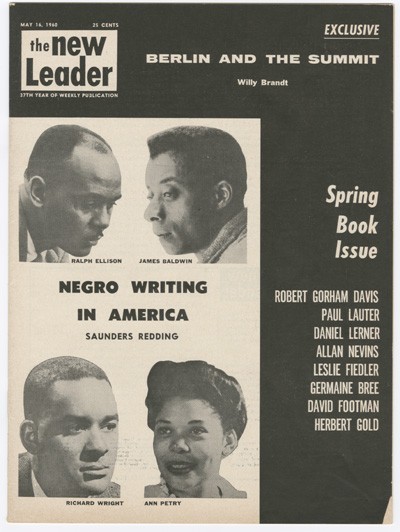Columbia's Rare Book & Manuscript Library Acquires Archive of The New Leader Magazine
NEW YORK, November 29, 2006 Columbia University's Rare Book & Manuscript Library has acquired the archive of The New Leader, a magazine of political opinion and cultural criticism. Founded in 1924 as a newspaper of the American Democratic Socialist movement, it went on to publish some of the most influential intellectual figures of the twentieth century. The Columbia Libraries will also host Myron Kolatch, The New Leader's executive editor from 1962 through its final issue in 2006, for a five-year appointment to develop an active New Leader website, put together a New Leader anthology, and write a history of the magazine.

During its eighty-two years of publication, The New Leader provided one of the first American forums for Soviet-era dissidents such as Aleksandr Solzhenitsyn, Milovan Djilas, and Joseph Brodsky, as well as for the vanguard of the U.S. civil rights movement, including Martin Luther King Jr., whose "Letter from Birmingham City Jail" appeared in the magazine's June 24, 1963 issue.
"The New Leader archives are a treasure," said Michael Janeway, professor of journalism and the arts at Columbia and a former New Leader associate editor and contributor. "They bring together an eclectic and vital set of strands from twentieth-century intellectual history. Important figures from the European and émigré anti-Stalinist left, liberal and radical non-Communist thinkers in this country, public officials, and some of our most distinguished literary and arts critics, all wrote for it. Lionel Trilling would be proud that The New Leader has found its home on the campus on which he taught."
Despite its origins in the anti-Stalinist wing of the American left and its association with many of the thinkers who would launch the neoconservative movement, The New Leader was known for its thoughtful independence from any single ideological camp and for the promotion of intelligent debate among contributors. These included such notable writers and thinkers as Hannah Arendt, Daniel Bell, Willy Brandt, Albert Camus, Ralph Ellison, Hubert Humphrey, Stanley Edgar Hyman, Arthur Koestler, Irving Kristol, Mary McCarthy, Dwight Macdonald, Arthur Miller, Hans Morgenthau, Daniel Patrick Moynihan, Howard Nemerov, Reinhold Niebuhr, George Orwell, Cynthia Ozick, Diane Ravitch, Bertrand Russell, Bayard Rustin, Arthur Schlesinger Jr., Lionel Trilling, and Elie Wiesel.
The Rare Book & Manuscript Library's New Leader archive will comprise over 200 linear feet of material, including editorial correspondence, manuscripts, original artwork, photographs, contracts, advertising, and other documents spanning the magazine's history.
"The New Leader archive at Columbia will provide an extraordinary resource for teaching and learning and research across numerous disciplines," said James G. Neal, Vice President for Information Services and University Librarian. "It will serve as a magnet and inspiration to students and researchers who care about the life of the mind and the role of excellence in journalism in our society."
Under the editorship of Sol Levitas, the Menshevik Russian exile who took over the magazine in 1937, The New Leader parted company with the American Socialist movement and published ground-breaking first-hand reports on the Moscow Trials, the gulag, and other abuses of human rights under the Soviet system. During Levitas's tenure, The New Leader also shifted to a magazine format, and began to attract the contributions of prominent anti-Communist liberals, many of whom later became known as the "New York intellectuals."
Myron Kolatch's forty-four year stewardship of the magazine was characterized by an expansion of The New Leader's intellectual and political range—covering the civil rights movement, the student protests of the 1960s, and the Iranian revolution—and the growth of its arts and culture pages. Kolatch's editorship also reflected his distaste for ideological publications that catered to the positions and prejudices of their readers, a practice which he dubbed "psychological breast-feeding," in a recent New York Times article on The New Leader's demise.
"I'm indeed pleased that Columbia has agreed to be the preserver and promoter of The New Leader's legacy," Kolatch said. "Not only is it an honor to in effect become part of a great university, but the housing of our archives here also reflects a generations-long relationship with prominent members of the faculty who were important voices in The New Leader's pages."
Kolatch will be joined on the fifth floor of Butler Library by Lisa Peet, former executive assistant for The New Leader, who will assist in the creation of The New Leader website and in the cataloging of the magazine's files. When organized and processed, The New Leader archive will be available for use. For further information, call the RBML at 212-854-5153.
Columbia University Libraries is one of the top ten academic library systems in the nation, with 9.2 million volumes, over 65,650 serials, as well as extensive collections of electronic resources, manuscripts, rare books, microforms, and other nonprint formats. The collections and services are organized into 25 libraries, supporting specific academic or professional disciplines. Columbia Libraries employs more than 400 professional and support staff to assist faculty, students, and researchers in their academic endeavors. The Libraries’ website at http://www.columbia.edu/cu/lweb/ is a gateway to its print and electronic collections and to its services.
The Rare Book & Manuscript Library owns over 500,000 rare books in some 20 book collections and almost 28 million manuscripts in nearly 3,000 separate manuscript collections. It is particularly strong in English and American literature and history, classical authors, children‘s literature, education, mathematics and astronomy, economics and banking, photography, the history of printing, New York City politics, librarianship, and the performing arts. Individual collections are as eclectic as they are extensive. For more information, please see: http://www.columbia.edu/cu/lweb/indiv/rbml/index.html